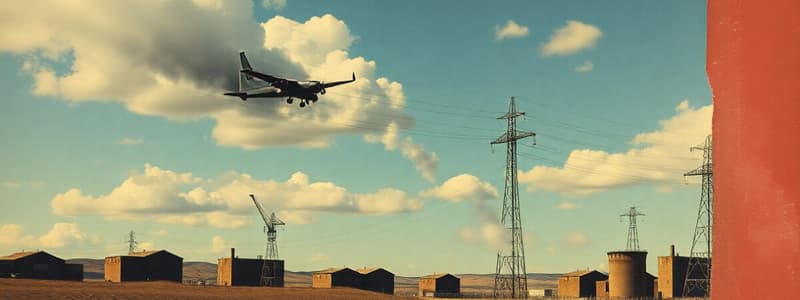Podcast
Questions and Answers
What is the primary purpose of Climeworks' Mammoth plant?
What is the primary purpose of Climeworks' Mammoth plant?
- To power geothermal energy stations
- To capture carbon dioxide from the atmosphere (correct)
- To plant trees and restore ecosystems
- To produce renewable energy for households
How does the Mammoth direct air capture (DAC) plant work?
How does the Mammoth direct air capture (DAC) plant work?
- It stores air in large tanks before releasing it back
- It pulls air through filters that trap carbon molecules (correct)
- It applies chemical reactions to dissolve carbon in water
- It uses solar panels to convert CO2 into oxygen
What is a criticism mentioned regarding direct air capture (DAC) plants?
What is a criticism mentioned regarding direct air capture (DAC) plants?
- They are cheaper than other carbon reduction strategies.
- They only operate effectively in sunny regions.
- They might detract from reducing fossil fuel use. (correct)
- They do not produce any emissions.
What is the expected annual CO2 capture capacity of the new DAC plant planned in Louisiana by Climeworks?
What is the expected annual CO2 capture capacity of the new DAC plant planned in Louisiana by Climeworks?
Which organization is developing the Mammoth DAC plant?
Which organization is developing the Mammoth DAC plant?
What type of energy powers the Mammoth DAC plant?
What type of energy powers the Mammoth DAC plant?
What is the impact of the Mammoth plant's carbon absorption capability equivalent to?
What is the impact of the Mammoth plant's carbon absorption capability equivalent to?
What does Klaus Lackner suggest about the efforts to reduce carbon emissions?
What does Klaus Lackner suggest about the efforts to reduce carbon emissions?
Flashcards
Direct Air Capture (DAC)
Direct Air Capture (DAC)
The process of removing carbon dioxide from the atmosphere and storing it elsewhere.
How Mammoth DAC plant works
How Mammoth DAC plant works
A technology that uses fans to pull air through specialized filters, trapping carbon molecules. These molecules are then mixed with water and pumped deep underground, where they react with volcanic rocks and eventually turn into stone.
Carbon Capture and Storage (CCS)
Carbon Capture and Storage (CCS)
The process of removing carbon dioxide from the atmosphere and storing it elsewhere, with the goal of reducing the concentration of this greenhouse gas.
Climeworks
Climeworks
Signup and view all the flashcards
DAC plant capacity
DAC plant capacity
Signup and view all the flashcards
Cost of DAC technology
Cost of DAC technology
Signup and view all the flashcards
Critics' argument about DAC
Critics' argument about DAC
Signup and view all the flashcards
Environmentalists' view on DAC
Environmentalists' view on DAC
Signup and view all the flashcards
Study Notes
Direct Air Capture (DAC) Technology
- Fossil fuel combustion releases CO2, contributing to global warming.
- Renewable energy sources (solar, wind) can reduce emissions but transitioning away from fossil fuels takes time.
- Climeworks is developing DAC technology to remove atmospheric CO2.
Mammoth DAC Plant
- Mammoth, the world's largest DAC plant, opened in Iceland on May 8, 2024.
- Emulates an in-home air purifier, using fans to capture carbon molecules.
- Carbon molecules are then mixed with water and pumped underground.
- Volcanic rocks react with the captured carbon, converting it into stone.
- Powered by geothermal energy, resulting in zero carbon emissions.
- Mammoth has a capacity to absorb 39,000 tons of CO2 annually (equivalent to removing over 7,000 cars from the road).
- Nine times larger than Climeworks' Orca plant (2021).
Criticisms and Perspectives on DAC
- Critics argue that DAC plants are expensive and divert resources from reducing fossil fuel use.
- Environmentalists, however, view DAC as a necessary complement to fossil fuel reduction.
- Klaus Lackner highlights DAC's substantial contribution to addressing climate change, emphasizing its potential to make a significant difference.
Future of DAC Technology
- Climeworks plans an even larger DAC plant in Louisiana (expected to capture 1 million tons of CO2 annually by 2030).
- Other companies like Occidental are also developing commercial-scale DAC plants (e.g., one in Texas expected to remove 500,000 tons annually by 2025).
- DAC technology is growing rapidly, potentially becoming more widespread and critical in the future, comparable to the evolution of a ubiquitous technology like smartphones.
- Advocates propose complementary actions like increased tree and plant planting for further carbon reduction.
Studying That Suits You
Use AI to generate personalized quizzes and flashcards to suit your learning preferences.




